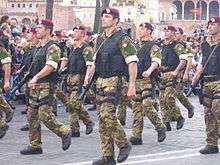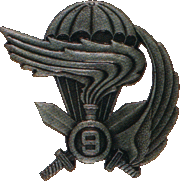9th Parachute Assault Regiment
| 9th Parachute Assault Regiment "Col Moschin" | |
|---|---|
|
Coat of Arms of the 9° Airborne Regiment | |
| Active | 1953 - present |
| Country |
|
| Branch |
|
| Type | Special Forces |
| Role |
Special Operations Direct action |
| Size | classified |
| Garrison/HQ | Livorno, Toscana |
| Nickname(s) | Il Nono (The ninth) |
| Motto(s) | Della folgore l'impeto - "Of the thunderbolt, the source / momentum" |
| March | Come Folgore dal Cielo |
| Engagements |
UNOSOM II Iraq War War in Afghanistan |
| Commanders | |
| Current commander | Colonel Paolo Fortezza |
The 9º Reggimento d'Assalto Paracadutisti (9th Parachutist Assault Regiment) Col Moschin ("Moschin Hill") is a Special Forces unit of the current Italian Army — in part due to its distinguished history, but also due to the arduous training which members must undertake. Training takes no less than two years for long-term members, and five months for short-term volunteers (with 1–2 years total military service).
Role
Roughly equivalent in number, tasking and quality to the world-famous British Army SAS, the 9th — or il nono as it is known in Italian military circles — is capable of operating in all environments. The roughly 150 members train in mountainous, wooded, desert, and amphibious terrain. The 9th's speciality is operating independently of outside support and far from friendly lines. From 2004, "Col Moschin" is integrated inside the Comando Forze Speciali Interarma (C.O.F.S.), Italy's special operations command.
History
The origins of the 9th Parachutist Assault Regiment can be found in the World War I. Among its precursors is the IX Reparto d'Assalto ("9th Assault Section"), known as the Arditi ('Brave or Bold / Tough Ones' - but the verb "ardire" or "to dare" suggests "The Daring" as a more proper translation), who were often tasked with preempting infantry assaults on the Italo-Austrian front lines. It was during this period that the 9th earned its reputation as a fierce fighting force. 'Going over the top', followed by the launch of hand-grenades deep into enemy territory, was commonplace. The 9th was responsible for the capture of numerous Austrian positions on Monte Grappa, including Col Moschin, and the Col della Beretta.
The inter-war years saw the demise of the 9th Section, and a similar unit was not reestablished until 20 July 1942, when World War II was in full swing. Dubbed the X Reggimento "Arditi" ('10th Regiment' "The Bold"), they conducted operations behind the enemy lines in Tunisia, Algeria and in Sicily after its allied occupation. After 8 September 1943 — the surrender of Italy to the Allies — the 1st Battalion of the 10th Regiment spent the next few years fighting its way up the Italian Peninsula in the Italian War of Liberation.
Disbanded in 1946, the 9th was reassembled as a company-level unit at the Cesano Infantry School in 1953. On 1 June 1954, the unit became the Reparto Sabotatori Paracadutisti ('Saboteur Parachute Section'), and in 1961, it mutated once more into the Battaglione Sabotatori Paracadutisti ('Saboteur Parachute Battalion'). Fourteen years later, it received the standard of the X Reggimento "Arditi", and became the 9º Battaglione d'Assalto Paracadutisti "Col Moschin" ('9th Parachute Assault Battalion' "Peak Moschin". In June, 1995 the unit expanded into a Regiment. In 2004, it was integrated into the COFSI - Comando Operativo Forze Operazioni Speciali ("Operational Command for Special Operations Forces").
As part of the Brigata Paracadutisti "Folgore" ('Parachutist Brigade' "Thunderbolt") — which distinguished itself in World War II by defending of Italian positions in North Africa so heroically that Winston Churchill dubbed them 'as fierce as lions' — the 9th Regiment has engaged in numerous post-World War II exploits.
As part of the peace treaty signed by Italy following World War II, Italy could not deploy armed forces outside of Italy for 25 years, except, of course, for the destruction of Nazi Germany and her allies. This restriction expired in 1970, but circumstances did not call upon Italian military participation in foreign missions until 1982. Since that time, the 9th has been engaged throughout the world.

Modern operational history
- In 1982, Italian paratroopers of the 9th took part in the multi-national UN-sponsored mission of establishing peace and security in parts of Lebanon that were shattered by years of civil war. The Italians achieved great operational success, and were widely praised for their work.
- In May 1991, the humanitarian crisis precipitated by Saddam Hussein led to hundreds of thousands of Kurd refugees in northern Iraq. The 9th was deployed to assist the people fleeing Saddam, following his defeat in the 1990–91 Persian Gulf War.
- Mafia assassinations of top Italian magistrates in 1992 resulted in the deployment of military forces to Sicily, including the 9th.
- From late 1992 to late 1993, the 9th was deployed to Somalia in Operation Restore Hope, a UN mission to alleviate the suffering of the Somali people, who were deeply affected by the on-going civil war. The "Nono" participated in the battle of "Check point Pasta".
- In 1994, rescue mission of civilians in Rwanda.
- The 9th was deployed within the IFOR to keep the peace in Bosnia following the Dayton Peace Accords of 1995. They served numerous tours of duty. They were also dispatched several times to Kosovo, following the NATO-Serbian War in 1999.
- Additional recent operations include a tour in Albania, following the near-collapse of the Albanian government in 1997, and an operation in East Timor, following that country's referendum for independence from Indonesia.
- In Afghanistan, the Incursori provides support of Italian troops engaged in ISAF. And in the Task Force 45.
- In Iraq, Operation Antica Babilonia (Italian contingent of Multinational force 2003 - 2006) includes a section of special forces operatives, from the 9th, the Carabinieri's GIS and the Navy's COMSUBIN, mostly deployed for patrol missions, training local police and Army, and to arrest suspects of terrorism.
- During 2011 military intervention in Libya, at least 40 commandos (maybe more) were sent on the ground to train, coordinate, assist in fighting alongside the rebels and for illuminating targets for NATO aircraft.
- In March 2016 it was reported that units have joined other western special forces in Libya to train, coordinate, and assist in fighting against local IS militias.
Composition

The 9th Parachute Assault Regiment "Col Moschin" is part of the Italian Army's Folgore Parachute Brigade, which is part of the 1st Defence Forces Command — composed of the front-line units of the new professional Italian Army.
The 9th itself is made up of the following subunits
- Compagnia Comando e Supporto Logistico (Command and Logistical Support Company)
- Compagnia Trasmissioni (Communications Company)
- 1° Battaglione Incursori (1st 'Raider' Battalion), which is composed of:
- 110°, 120°, & 130° Incursori (110th, 120th, & 130th 'Raider' Companies)
- 111th Compagnia Guastatori ('Sapper' Company).
RAFOS - Reparto Addestramento Forze per Operazioni Speciali (Section for Special Operations Forces Training)
- 101ª Compagnia Allievi (101st Cadet Company)
Equipment
- Beretta 92 9 mm
- Beretta 8000 Cougar 9 mm
- FN Five-seveN
- HK MP5
- Colt M4 SOPMOD
- Beretta SCP 70/90
- Beretta ARX 160
- FN SCAR
- Steyr AUG
- FN P90 cal 5.7 × 28mm
- HK MP-7 cal 4.6 × 30mm
- Benelli M4 Super 90
- Beretta RS202
- Heckler & Koch MSG90 cal 7.62 × 51 mm
- Accuracy International AWM cal .338 Lapua Magnum
- Sako TRG-42 cal .338 Lapua Magnum
- Barrett M82A1 cal 12.7 mm
- SR-25 cal 7.62×51mm
- HK 416
- MK48 cal 7.62×51mm
See also
External links
- (Italian) 9° "Col Moschin" website
- (Italian) 9º Reggimento d' Assalto Incursori Paracadutisti "Col Moschin"
- (English) Special Operations page.
- (Italian) Italian Army Website
- (Italian) Veteran association of 9th Parachute Assault Regiment
